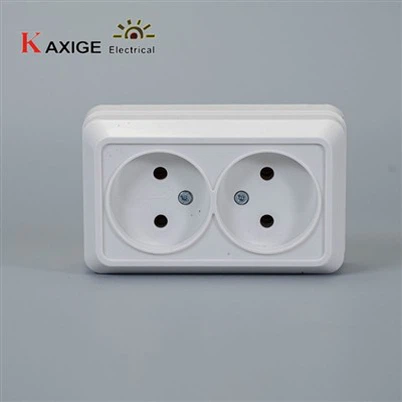Can old switches and sockets cause electrical fires?
Leave a message
Old switches and sockets are common components in electrical systems, both in residential and commercial settings. As a supplier of old switches and sockets, I often encounter concerns from customers about whether these aging electrical devices can cause electrical fires. In this blog post, I'll explore this question from a scientific and practical perspective, discussing the potential risks associated with old switches and sockets and how to mitigate them.
Understanding the Basics of Electrical Fires
Before delving into the relationship between old switches and sockets and electrical fires, it's essential to understand what causes electrical fires in general. Electrical fires typically result from one of the following factors: overheating, short circuits, and arcing.
Overheating occurs when an electrical device or circuit is subjected to more current than it can safely handle. This can be due to overloading, where too many appliances are connected to a single circuit, or due to a fault in the device itself. Short circuits happen when a low - resistance path is created between two conductors, allowing a large amount of current to flow. Arcing is the formation of an electric arc, which is a luminous discharge of electricity across an insulating medium, often caused by loose connections or damaged conductors.
Risks Associated with Old Switches and Sockets
1. Wear and Tear
Over time, the mechanical components of switches and sockets can wear out. The contacts inside a switch, for example, may become pitted or corroded. Pitted contacts can increase the resistance at the connection point. According to Ohm's Law (V = IR, where V is voltage, I is current, and R is resistance), when resistance increases, for a given voltage, the power dissipated (P = I²R) at the contact point also increases. This increased power dissipation leads to overheating, which can potentially ignite nearby combustible materials.
2. Loose Connections
As switches and sockets age, the connections can become loose. Loose connections can cause arcing, as the electrical current has to jump across small gaps between the conductors. Arcing generates intense heat and can easily ignite insulation materials or other flammable substances in the vicinity. Moreover, loose connections can also lead to intermittent electrical contact, which can cause appliances to malfunction and further increase the risk of overheating.
3. Outdated Design and Standards
Old switches and sockets may have been designed and manufactured to meet outdated electrical standards. These standards may not adequately address modern electrical loads and safety requirements. For instance, older sockets may not have proper grounding mechanisms or may not be rated to handle the high - power appliances commonly used today. This mismatch between the capacity of the old switches and sockets and the electrical demands of modern devices can lead to overheating and electrical fires.
Case Studies and Statistics
Numerous studies have shown a correlation between old electrical systems, including switches and sockets, and electrical fires. According to a report by the National Fire Protection Association (NFPA), electrical distribution and lighting equipment were involved in 6.5% of all reported home fires in the United States between 2014 - 2018, and many of these incidents were attributed to aging electrical components.
In some real - world cases, old switches with worn - out contacts have been found to be the cause of fires in older buildings. These fires often start in the walls, where the heat generated by the faulty switch can ignite the insulation and wooden framing.
Mitigating the Risks
1. Regular Inspections
Regular inspections of switches and sockets are crucial for identifying potential problems. Homeowners and building managers should look for signs of wear, such as discoloration, charring, or loose connections. If any of these signs are present, the switch or socket should be replaced immediately.
2. Upgrading to Modern Devices
Replacing old switches and sockets with modern, code - compliant devices can significantly reduce the risk of electrical fires. Modern switches and sockets are designed to handle higher electrical loads, have better insulation, and are equipped with safety features such as arc - fault circuit interrupters (AFCIs) and ground - fault circuit interrupters (GFCIs).
As a supplier, I offer a range of high - quality old - style switches and sockets that meet modern safety standards. For example, our 73B 1 Gang Socket 2P is designed with robust materials and advanced electrical engineering to ensure safe and reliable operation. Our 73B Dimmer Switch provides smooth dimming functionality while maintaining high - level safety. And our 73B Switch and Socket Combination offers a convenient and space - saving solution for various electrical needs.
3. Professional Installation
Proper installation of switches and sockets is essential for safety. It is recommended that all electrical work be carried out by a qualified electrician. A professional electrician can ensure that the switches and sockets are installed correctly, with proper grounding and secure connections.


Conclusion
While old switches and sockets can pose a risk of electrical fires due to wear and tear, loose connections, and outdated design, these risks can be effectively managed through regular inspections, upgrading to modern devices, and professional installation. As a supplier of old switches and sockets, I am committed to providing products that combine the charm of vintage design with modern safety features.
If you are interested in our products or have any questions about electrical safety, I encourage you to contact us for a procurement discussion. Our team of experts is ready to assist you in finding the right switches and sockets for your needs.
References
National Fire Protection Association. (2014 - 2018). Home Structure Fires Involving Electrical Distribution and Lighting Equipment.
Physics textbooks on electrical engineering principles, including Ohm's Law and power dissipation concepts.






